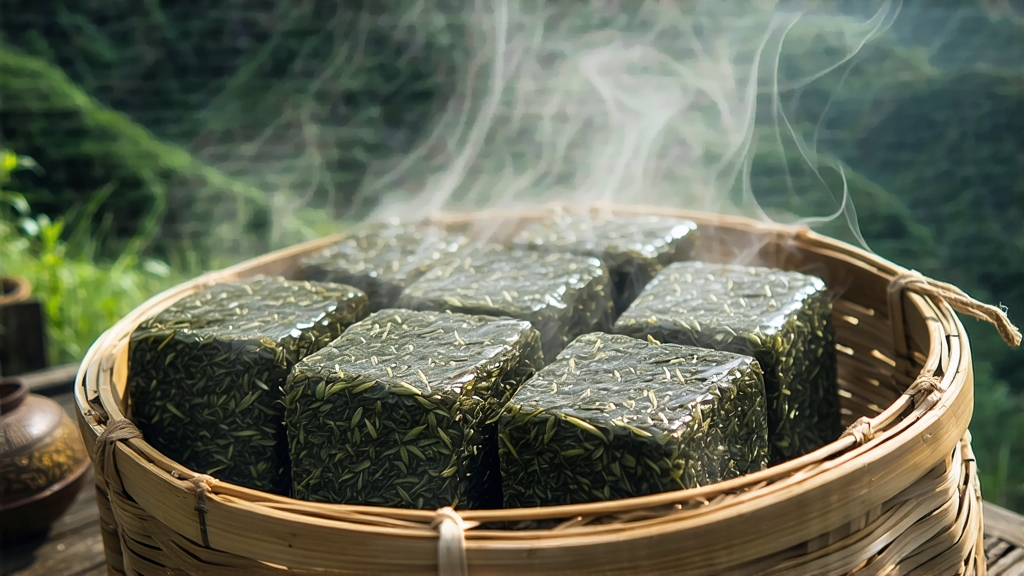
Tucked away in the humid, karst-pocked mountains of southern China’s Guangxi Zhuang Autonomous Region, Liu Bao tea has spent four centuries quietly perfecting the art of microbial alchemy. To most outsiders “dark tea” begins and ends with Yunnan’s Pu-erh, yet Liu Bao is the older, subtler sibling—fermented, pressed, and aged in woven bamboo baskets whose sweet-grass scent becomes part of the leaf’s DNA. This article invites the global tea lover to discover why Liu Bao was once the currency of overseas Chinese coolies, how its dual fermentation creates a liquor the color of garnet and the texture of silk, and why a single 1980s basket recently sold at auction for more than a vintage Bordeaux case.
-
From Border Town to Maritime Silk Road
The name Liu Bao simply means “six fortresses,” a cluster of hamlets southwest of Wuzhou where the story begins during the Ming Wanli era (1573–1620). Caravans carried rough-green leaves down the Liu Bao River to the Xunjiang, then to the Pearl River delta and the port of Guangzhou. There, clipper ships bound for Southeast Asia stowed the tea as ballast; the humid hold jump-started a secondary fermentation that delighted miners and dockworkers in Kuala Lumpur, who swore the brew cured rheumatism and “cooled the blood” in tropical heat. By 1800 Liu Bao was listed in the Qing maritime customs archives as “black cargo tea,” taxed at a lower rate than green because it was considered coarse—an irony, since those same leaves are now collector’s items. -
The Microbial Palette: Leaves, Water, and Air
Liu Bao starts with a local large-leaf cultivar, Camellia sinensis var. sinensis f. pubilimba, whose thick cell walls offer ample pectin for microbes to feast upon. Picking standard is one bud with three or four leaves, plucked after Qingming when amino acids peak. The magic, however, lies not in the garden but in the piling room: a humid bamboo shed where ambient yeasts, Aspergillus niger, and the prized “Golden Flower” (Eurotium cristatum) drift in on mountain mist. Unlike Pu-erh’s wet-pile (wo dui) that lasts 45–60 days, Liu Bao’s “cold pile” (leng dui) ferments gently for 25–30 days at 28–32 °C, allowing Eurotium to dominate and impart the characteristic betel-nut aroma (binglang xiang) that connoisseurs prize. -
Crafting the Basket: A Choreography of Fire, Steam, and Time
Step 1: Sun-withering for 4–6 hours reduces moisture to 65 %.
Step 2: Kill-green in a 200 °C wok for eight minutes halts oxidation but preserves microbial spores.
Step 3: Rolling along bamboo screens twists the leaves into thick cords, rupturing cells for future fermentation.
Step 4: The pivotal “piling”: leaves are heaped 70 cm deep, misted with mountain spring water, and covered with wet jute. Every three days the pile is turned by barefoot workers who read the temperature with their soles—when the core feels like a fevered brow, it is time to aerate.
Step 5: After 28 days the mass is steamed for three seconds, just enough to soften, then packed into 40 kg bamboo baskets lined with wild banana leaves. The baskets are stacked in riverside caves where relative humidity hovers at 85 %. Here the tea will rest for a minimum of three years, breathing through the lattice, slowly darkening from olive to umber to obsidian. -
The Flavor Arc: Young, Middle-Aged, and Antique
A 2019 basket offers cocoa nib, dried longan, and a faint smokiness reminiscent of lapsang souchong’s polite cousin. At ten years the liquor turns garnet, the aroma shifts to camphor and wet mahogany, while the taste acquires a malty thickness that coats the tongue like PX sherry. Thirty-year Liu Bao is liquid antique: rosewood, incense resin, and a cooling betel-laced finish that lingers for minutes. The Chinese describe this evolution as “Chen, Xiang, Yun, Gan”—aged, aromatic, rhythmic, sweet—four syllables that map a sensory timeline.